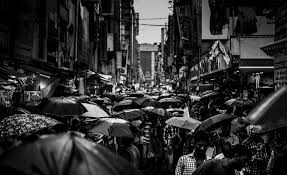Urban India has labyrinthine alleys washing over with monsoons and dark stories. Light and darkness, hope and despair, intertwine, revolution against the weakening brain twist our human nature.The intertwining of light and shadow, hope and despair will generate not only despair, but a story full of hope, friendship, and love. This article investigates how noir’s hyperrealist treatment of urban India’s distinct atmosphere has reflected and been reflected by the country’s emergent modern identity.
The Emergence of Indian Urban Noir
Historical Context
The cunning protagonist, dissolved of the shades of gray that traditional noir favours, works in the film industry of 50′s Bombay. Post-independence urbanisation saw cities such as Mumbai, Delhi, and Kolkata expan d rapidl y with population growth, and a lack of infrastructure led to the emergence of slums, spaw ne d by shanty towns and conurbation s, bra ced with land use violations and political corruption. They gave birth to the rich soil of noir fiction and the dark underside of urban existence.
Literary Foundations
Indian literature began to mirror these urban complexities. Authors like Vikram Chandra, with his novel Sacred Games, delved deep into Mumbai’s underworld, weaving tales of gangsters, corrupt officials, and existential dilemmas. Chandra’s work, rich in detail and philosophical undertones, set a precedent for Indian noir literature. (Bombay Noir)
Cinematic Representations
Bollywood’s Tryst with Noir
Indian cinema, particularly Bollywood, embraced noir elements, blending them with local narratives. Films like Satya (1998) and Company (2002) portrayed the gritty realities of Mumbai’s gang wars, while Black Friday (2004) depicted the aftermath of the 1993 Bombay bombings. These films combined stylistic noir elements with socio-political commentary.
Monsoon Shootout: A Case Study
Monsoon Shootout (2013) stands out as a quintessential Indian noir film. Set against the backdrop of Mumbai’s monsoon season, it explores the moral dilemmas faced by a rookie cop. The film’s non-linear narrative and atmospheric visuals encapsulate the essence of noir. (Monsoon Shootout)
Urban Landscapes as Characters
The Role of the Monsoon
The monsoon, with its torrential rains and overcast skies, adds a layer of melancholy and unpredictability to urban settings. Flooded streets, dimly lit alleys, and the constant patter of rain create an ambiance that complements noir narratives, symbolizing both cleansing and chaos.
Slums and Shadows
Areas like Dharavi in Mumbai, one of the world’s largest slums, embody the contrasts of urban India. Despite challenges like overcrowding and inadequate sanitation, Dharavi thrives with entrepreneurial spirit and cultural diversity. Its narrow lanes and bustling workshops have been both the setting and subject of numerous stories, highlighting resilience amidst adversity. (Dharavi)
Socio-Political Underpinnings
Crime and Corruption
Urban India’s rapid growth has often outpaced infrastructure development, leading to pockets of lawlessness and corruption. Noir narratives delve into these issues, portraying characters who navigate a world where moral lines are blurred, and survival often necessitates compromise.
Identity and Alienation
The influx of migrants to urban centers has led to cultural amalgamations and tensions. Noir stories often focus on characters grappling with identity crises, alienation, and the struggle to find belonging in sprawling metropolises.
The Future of Indian Noir
Digital Platforms and Global Reach
With the rise of streaming services, Indian noir has found a global audience. Series like Sacred Games have garnered international acclaim, showcasing India’s capacity to produce compelling noir narratives that resonate universally. (Bombay Noir)
Emerging Voices
A new generation of writers and filmmakers is pushing the boundaries of the genre, incorporating regional stories, diverse characters, and contemporary issues. This evolution ensures that Indian noir remains dynamic and reflective of the nation’s changing landscape.
The noir narratives of urban India are a mirror to society its complexities, its contradictions, its spirit of survival. These tales, both in literature and film, explore the human mind with regards to morality, identity, and survival. As the cities grow, so will the stories that arise from their monsoon-drenched roads and dark corners.
Frequently Asked Questions (FAQ)
Q1: What defines Indian urban noir?
A1: Indian urban noir combines elements of traditional noir such as moral ambiguity, crime, and complex characters nwith the unique socio-cultural and political landscapes of Indian cities.
Q2: How does the monsoon influence noir narratives in India?
A2: The monsoon adds atmospheric depth to stories, symbolizing both renewal and chaos. Its presence enhances the moodiness and unpredictability characteristic of noir.
Q3: Are there notable Indian noir films to watch?
A3: Yes, films like Satya, Company, Black Friday, and Monsoon Shootout are acclaimed examples of Indian noir cinema. (Monsoon Shootout)
Q4: How has Indian noir evolved with digital platforms?
A4: Streaming services have expanded the reach of Indian noir, allowing for more diverse storytelling and global audiences, as seen with series like Sacred Games.
Q5: What themes are prevalent in Indian noir literature?
A5: Common themes include crime, corruption, identity crises, urban alienation, and the moral complexities of survival in rapidly changing cities.